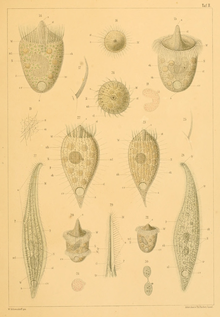- Didinium
-
Didinium Didinium balbanii illustration (top of the pictu), as well as in Dinophrya lieberkuehnii in the center and Lionotus fasciola at the bottom) Scientific classification Domain: Eukaryota (unranked): Alveolata Phylum: Ciliophora Class: Litostomatea Order: Haptorida Family: Didiniidae Genus: Didinium
Stein, 1859Species Didinium alveolatum
Didinium armatum
Didinium impressum
Didinium balbianii
Didinium chlorelligerum
Didinium cinctum
Didinium coccineum
Didinium commune
Didinium faurei
Didinium fulgens
Didinium gargantua
Diduoim maculosum
Didinium nasutum
Didinium peyrefittense
Didinium protectum
Didinium rostratumDidinium is a genus of ciliophora. They are free-living carnivores, mostly found in fresh and brackish water environments, although at least three marine species are known. Their diet consists primarily of Paramecium, but some species such as D. gargantua feed on other protists including dinoflagellates, cryptomonads, and green algae.
Contents
Structure
Didinium have two ciliary bands, called pectinellae, encircling the organism. This distinguishes them from the related genus Monodinium, which only have a single band except during cell division. The pectinellae are used to move through water by rotating the cell around its axis. Didinium are rounded, oval, or barrel-shaped and range in length from 40 to 200 µm. At the anterior end, a cone-shaped structure protrudes which encloses the cytostome or "mouth" opening, as found in other haptorian ciliates. The dimension of cone varies among the different species. The nucleus may also appear curved in an arched, U-shape. Didinium reproduce via binary fission asexually, or sexually via conjugation. A didinium moves by beating its cilia.
D. nasutum
Much of what is described for this genus is based on the extensive studies of a single species, Didinium nasutum. A voracious predator, D. nasutum, employs specialized structures called toxicysts (some sources refer to these structures as trichites) to ensnare and paralyze the ciliary movement of its prey, Paramecium. Once captured, the Paramecium, is engulfed whole by D. nasutum through its anterior cytostome.
In the absence of its Paramecium prey, D. nasutum will encyst, lying dormant within a protective coating. The cysts have been shown to remain viable for at least 10 years. When the cyst form of D. nasutum is exposed to its exclusive Paramecium food source it will excyst. At least one laboratory study showed that other conditions can trigger encystment in D. nasutum, such as the build-up of excessive waste products in the environment and other stimuli.
Phylogenetic analysis
Phylogenetic analysis of the ciliates has presented a challenge to researchers due to the presence of both a "germ line" micronucleus containing the genes passed from generation to generation and a "somatic" macronucleus within each organism. Products of conjugation, micronuclear meiosis and fusion to form the zygote are followed by mitotic division and the formation of a macronucleus. Throughout this complex process the chromosomes undergo many processes that affect their composition, making phylogenetic analysis more difficult. In fact, at least two articles conclude that the Haptoria are not a monophyletic group.
References
- Beers, C. Dale. 1925. Encystment and the Life Cycle in the Ciliate Didinium Nasutum. Proceedings of the National Academy of Sciences. Vol. 11: 9, pp. 525-528
- Beers, C. Dale. 1929. On the Possibility of Indefinite Reproduction in the Ciliate Didinium without Conjugation or Endomixis. American Naturalist, Vol. 63, No. 685 pp. 125-129
- Beers, C. Dale. 1937. The Viability of Ten-Year-Old Didinium Cysts (Infusoria). American Naturalist, Vol. 71, No. 736, pp. 521-525
- Cameron; Stephen L., Andre-Denis G. Wright And Peter J. O’donoghue. 2003. An Expanded Phylogeny of the Entodiniomorphida (Ciliophora: Litostomatea). Acta Protozool. 42: 1-6
- Hara, Ritsuo; and Hiroshi Asai. 1980. Electrophysiological responses of Didinium nasutum to Paramecium capture and mechanical stimulation. Nature 283, 869 -870
- Hausmann, Klaus; Hulsmann, Norbert; Radek, Renate; Protistology (3rd Edition) 2003. E. Scheizerbart’sche Verlagsbuchhandlung.
- Hewett, Steven W. 1987. Prey Size and Survivorship in Didinium nasutum (Ciliophora: Gymnostomatida). Transactions of the American Microscopical Society. Vol. 106: 2 pp. 134-138
- Integrated Taxonomic Information System (ITIS). Taxonomic information on plants, animals, fungi, and microbes of North America and the world. http://www.itis.gov/index.html Accessed October 12, 2006.
- Karajan, Bella P.; Vladimir I. Popenko, and Olga G. Leonova. 2003. Fine structure of nucleoli in the ciliate Didinium nasutum. Protistology 3 (2), 99-106
- Reece, Kimberly S.; Mark E. Siddall, Nancy A. Stokes, and Eugene M. Burreson. 2004. Molecular Phylogeny Of The Haplosporidia Based On Two Independent Gene Sequences. Journal of Parasitology, 90(5) pp. 1111–1122.
- Riley JL, Katz LA. 2001. Widespread distribution of extensive chromosomal fragmentation in ciliates. Mol Biol Evol. 2001 Jul; 18(7):1372-7.
- Rosenberg, Lauren E. 1938. Cyst Stages of Opisthonecta henneguyi. Transactions of the American Microscopical Society, Vol. 57, No. 2, Sixtieth Anniversary Volume, pp. 147-152.
Ciliophora Spirotrichea (Stylonychia) · Litostomatea (Didinium, Balantidium) · Phyllopharyngea (Tokophrya) · Nassophorea (Nassula) · Colpodea (Colpoda) · Oligohymenophorea (Tetrahymena, Ichthyophthirius, Vorticella, Paramecium) · Plagiopylea (Plagiopyla) · Prostomatea (Coleps)OtherMyzozoa Plasmodiidae/Haemosporida (Plasmodium, Haemoproteus, Leucocytozoon)
Piroplasmida (Babesia, Theileria)Adele-Haemogregarina, Hepatozoon, KaryolysusEimeri-Cryptosporidiidae (Cryptosporidium)
Eimeriidae (Isospora, Cyclospora, Eimeria)
Sarcocystidae (Toxoplasma, Sarcocystis, Besnoitia, Neospora)Agamo-Rhytidocystidae (Rhytidocystis)GregariniaGregarinasina (Gregarina)ColpodellidaeChromeridaChromera velia, Vitrella brassicaformisWith a theca: Peridiniales (Pfiesteria, Peridinium) · Gonyaulacales (Ceratium, Gonyaulax) · Prorocentrales (Prorocentrum) · Dinophysiales (Dinophysis, Histioneis, Ornithocercus, Oxyphysis)
Without theca: Gymnodiniales (Gymnodinium, Karenia, Karlodinium, Amphidinium) · Suessiales (Polarella, Symbiodinium)
Noctilucales (Noctiluca)Syndiniales: Amoebophryaceae (Amoebophyra) · Duboscquellaceae (Duboscquella) · Syndiniaceae (Hematodinium, Syndinium)OtherRelatedCategories:- Ciliates
Wikimedia Foundation. 2010.

